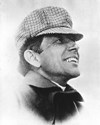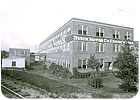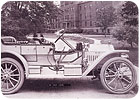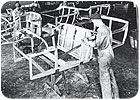
Imagine a world without GPS navigation systems, text messaging, reality TV shows or steroid use in baseball. Those things were unimaginable 100 years ago.
General Motors Co. (GM) was formed in New Jersey on Sept. 16, 1908. A former carriage maker named William “Billy” Durant started the company with a working capital of $2,000 and set out to change the auto industry. Within 12 days, stock offerings generated $12 million. Durant’s goal was to create a consortium similar to the one that had been established in the steel industry a few years earlier when U.S. Steel was created.
At the time, the auto industry was extremely fragmented. There were more than 250 automakers in the United States. Due to consolidation, the number of companies eventually dropped to 108 by 1920 and to only 44 by 1929.
Durant had already built the Durant-Dort Carriage Co. (Flint, MI) into the largest company in its industry. The firm assembled 150,000 carriages annually in 14 different plants. In fact, the company actually pioneered a moving carriage assembly line. But, Durant was eager to try his entrepreneurial skills in the burgeoning horseless carriage industry.
General Motors acquired the Buick Motor Co. (Flint, MI) on Sept. 29, 1908. Buick was the star of Durant’s new holding company. It was the largest automaker in the United States, producing more vehicles than its two biggest rivals: Cadillac and Ford.
Buick’s state-of-the-art factory assembled 8,820 vehicles in 1908, such as the brand new Model 10. The 22.5-hp vehicle was officially described as “a gentleman’s light four-cylinder roadster.” It featured a long, low profile and was priced at $900.
Buick boasted of having “the largest machine shop in the world” and “the largest motor manufacturing plant under one roof.” Its engineers developed the overhead valve engine earlier in 1908. By locating the valves in the top of the combustion chamber, unlike other engines of the time, the design allowed the engine to breathe more efficiently and develop more horsepower per cubic inch of displacement than other engines.
General Motors grew quickly. In November 1908, GM acquired the Olds Motor Works (Lansing, MI). In 1909, Durant purchased the Cadillac Automobile Co., the Oakland Motor Car Co. (this company was renamed Pontiac in the early 1930s) and the Rapid Motor Vehicle Co. (the predecessor of the GMC truck division). By the end of 1909, GM controlled 19 percent of the U.S. market.
Durant even tried to acquire Ford Motor Co. twice, but he was unsuccessful both times. In 1908, he offered Henry Ford $3 million. The next year, Durant offered $8 million. But, the deal fell through because of reluctant bankers.
Along the way, GM also gobbled up a network of parts suppliers, such as the Champion Ignition Co. and Weston-Mott Co. By 1910, Durant had added more than 30 companies to the General Motors empire. Between 1908 and 1910, Buick’s sales doubled and Cadillac’s tripled. However, all of the quick expansion and overnight success burdened the young company.
Durant was caught short of working capital in 1910 and was obliged to accept a multimillion loan from powerful financiers in exchange for absolute voting rights on GM stock over a 5-year period. Durant regained control of the company in 1915, but he was forced out again in 1920.

Buick formed the original heart and soul of GM. In 1908, it was the largest automaker in the United States and operated a state-of-the-art factory in Flint, MI.
A Novelty Item
When GM was founded in 1908, automobiles were still a novelty. Although more than 190,000 vehicles were registered nationwide, driving was considered to be a “sport” that was only enjoyed by the well-to-do. Most vehicles featured open wood bodies and right-hand steering columns. Some were equipped with canvas tops. Contemporary advertising featured products such as safety goggles and dust-proof motor veils.Automobiles were even considered a spectacle at the Ringling Bros. Circus 100 years ago, which featured a young daredevil named Mademoiselle La Belle Roche. She thrilled audiences by driving a small car down a tall, rollercoaster-like structure that launched the vehicle into the air and then performed a double somersault before landing safely on a ramp.
Annual vehicle production in 1908 was 63,500 cars and 1,500 trucks. The market was choked with competition from companies that are now long-gone, such as Benner, Chicago Motor Buggy, Duplex, Hobbie, Midland, Moon, Sultan and Waldron.
New six-cylinder vehicles were the stars at auto shows in Chicago and New York. Because hand-cranking was required to start gasoline engines, electric cars were popular. New innovations in 1908 included magnetic speedometers, silent timing chains and motor-driven horns. Mechanical improvements included easier component access, larger brakes, better-enclosed clutches and easier-to-use controls.
The founding of GM didn’t register too much attention in 1908. In fact, the event went largely unnoticed in the news media. The big business story on Sept. 16 was that the White Star Line would begin construction of the world’s largest ocean liner, to be called theTitanic.
People were still talking about an audacious cross-country car race from New York to Paris that was held a few months earlier. At the same time, Henry Ford was getting ready to unveil a new vehicle called the Model T.
The Great Race was billed as the first around-the-world automobile race. It was sponsored by France’sLe Matinnewspaper and theNew York Times, which proclaimed the contest to be “the longest and most perilous trip ever undertaken by man.” Thirteen cars were entered in the race, but only six vehicles left Times Square on Feb. 12, 1908.
The vehicles included a 30-hp DeDion from France, a 40-hp Protos from Germany and a 40-hp Zust from Italy. The only American entry in the race was a 60-hp Thomas Flyer from the E.R. Thomas Co. (Buffalo, NY). The car, entered at the last minute, had one driver and one mechanic, in addition to a newspaper reporter. However, it had no top, no heater and no windshield.
After leaving New York City, the vehicles headed West toward Chicago. Along the way, they encountered primitive dirt roads in Indiana, Ohio and Pennsylvania that often consisted of little more than wagon-wheel ruts. Dust, ice, mud, rain and snow were major obstacles. It took 13 days to reach Chicago, which was the first official stop. Ironically, some of the cars were pulled out of snowdrifts in Indiana by horses.
The race continued on across the plains, but along the way, two of the teams dropped out. Because primitive many roads were impassable, the cars often straddled railroad tracks and followed the right of way. The cars were loaded onto a ship in Seattle and crossed the Pacific to Yokohama, Japan, and Vladivostok, Russia.
While traversing Siberia, the racers encountered harsh wintry conditions. After traveling more than 13,000 miles under its own power and thousands of additional miles at sea, the Protos was the first vehicle to arrive in Paris, on July 26, more than five months after leaving New York. After encountering mechanical problems, such as a blown transmission and a leaky radiator, the Thomas Flyer arrived four days later.
However, the Protos received a controversial 30-day penalty for various shortcuts and rules infractions. As a result, the Flyer was declared the winner. It officially completed the race in 169 days, averaging 107 miles a day. Because of its infraction, the Protos was 26 days behind. The only other finisher was the Zust, which was 48 days behind the Flyer.
TheNew York Timescalled the event “the greatest automobile race ever.” In an editorial a few days after the race ended, the newspaper accurately predicted that “the self-moving car is to play a very prominent part in our future history.” The race proved that the automobile was a reliable and dependable form of transportation. It also helped jump-start the U.S. auto industry.
Up until 1908, most people thought that Europeans built better cars. In the years following the race, sales of American cars soared. Ironically, the Thomas company went out of business in 1912.
The New York to Paris race also led to various improvements in roads and highways in the United States. Newspapers reports about the race deplored the horrible condition of American roads. Asphalt was invented in 1910 and construction of the Lincoln Highway, the first transcontinental road, began in 1912.
The race was fictionalized into a popular motion picture in the mid-1960s. Today, the Flyer is on display at the National Automobile Museum in Reno, NN, in addition to the 1,400-pound trophy that the E.R. Thomas Co. received. The Protos is displayed at the Deutsches Museum in Munich, Germany.
Approximately 3 miles north of where GM’s world headquarters stand today, Henry Ford and his colleagues were busy in September 1908 putting the finishing touches on a secret 2-year-long project to develop a car “for the common man.” On Oct. 1, Ford unveiled his “baby,” a 4-cylinder, 20-hp, 5-passenger touring car with an $850 price tag.
After a full-page ad appeared in the Oct. 3 issue of theSaturday Evening Post, the company was swamped with inquiries. Ford offered a vehicle that featured durable simplicity. Because of its high ground clearance, short turning radius and high power-to-weight ratio, the Model T could go almost anywhere.
By developing a reliable, low-priced “universal car,” Ford’s strategy was the exact opposite of Durant’s goal of offering a broad variety of brands as well as different models. For the next 19 years, Ford only produced the Model T, while GM pioneered the concept of selling a wide array of vehicles. Henry Ford dominated the auto industry until GM’s Chevrolet division started to outpace its archrival in the late 1920s.
Ford’s big breakthrough at the time [the company didn’t unveil its famous moving assembly line until 6 years later] was the use of vanadium alloy steel, which was tough, light and shock-resistant. It allowed Ford and his colleagues to develop axles, gears, springs, steering gear and other components that were strong and lightweight.
The Model T featured a planetary transmission system. Unlike many other vehicles at the time, the brake, clutch and gears were all incorporated within the transmission. Ford also cast the engine in one block. Other mechanical novelties included a detachable cylinder head and a magneto built into the flywheel.

In 1908, Oldsmobile produced 1,000 Model Ms.
A Different World
One hundred years ago, the world was a very different place. According to Jim Rasenberger, author ofAmerica 1908(Simon & Schuster Inc.), “it was a world of seemingly boundless innovation-everything was bigger, better, faster and greater than before.”In 1908, steam power was the rule rather than the exception in both transportation and industry. More than 80 percent of Americans lived without electricity in their homes. But, all sorts of new time-saving electric appliances were starting to appear, such as mixers, razors and vacuums.
The entire population of the United States was 88,710,000-less than one-third of today’s population. More than 50 percent of Americans lived in rural surroundings and one-third of all working-age people made their living from the land. There were nearly 20 million horses in the country-approximately one horse for every four people.
Streetcars and cobblestone streets were a common sight in cities, where it was common to hear the clip-clop of horse-drawn wagons. In New York City alone, more than 120,000 horses each dropped about 22 pounds of manure per day on the streets, for a total daily deposit of more than 2 million pounds. “When the manure dried, it drifted through the air as a thick dust that infected nasal passages and respiratory tracks,” says Rasenberger.
Many physicians and health officials considered automobiles to be a remedy to air pollution. “Not only did they offer the benefits of a restorative drive in the fresh air of the countryside, but they also promised cleaner air within the cities,” explains Rasenberger.
During the Edwardian era, people wore hats and dressed conservatively. Women wore bulky skirts and bustles topped by enormous feathered hats. Men rarely went outside without wearing a suit and a derby or bowler.
There was a tremendous amount of social unrest in 1908, because there were vast disparities between the rich and poor. Sixty percent of America’s wealth was controlled by only 2 percent of the population. Anarchists and socialists helped flame the fervor in dense urban settings with outdoor rallies, fiery speeches and occasional bombings. Lynchings and mob action were not uncommon, especially in rural environments.
“Reality provided a surplus of fantastical images to furnish dreams in 1908,” says Rasenberger. “Unfortunately, it also provided ample fodder for nightmares.”

One hundred years ago, car bodies were made out of wood. One of the leading suppliers, Fisher Body Co., was formed in 1908. It supplied GM and later became part of the company.
Elsewhere in the World
While Billy Durant was busy founding the company that would soon become the largest automaker in the world and the backbone of the U.S. economy, other momentous events were occurring elsewhere. Here’s a brief glimpse at some headlines from the world of business, science, politics, consumer products, sports and entertainment:
- Americans were enthralled by the exploits of explorers Frederick Cook and Robert Peary, who each set out on quests to become the first person to reach the North Pole. Cook claimed that he succeeded, but he was later dismissed. Peary failed, but he succeeded the following year.
- A major earthquake in southern Italy killed more than 100,000 people.
- Republican William Howard Taft was elected the 27th president of the United States.
- A mysterious explosion in Siberia left more than 800 square miles of scorched earth and more than 80 million felled trees. It was caused by a giant asteroid that exploded in the sky over the Tunguska River.
- Henry Leland received the Dewar Trophy from the Royal Automobile Club of England for developing the first vehicle equipped with interchangeable parts.
- The Chicago Cubs became the first team to win back-to-back World Series, by beating the Detroit Tigers 4-1. The Cubs have appeared in several World Series since then, but they have not won.
- Canadian Peter Robertson invented a square-headed screw.
- The tallest structure in the world, the 41-story Singer Building, opened in New York City. In 1909, the 700-foot-tall Metropolitan Life Tower surpassed it.
- Orville Wright became the first person to fly an aeroplane for more than 1 hour.
-
Anne of Green Gables was first published.
- Army lieutenant Thomas Selfridge became the first passenger killed in a plane crash.
- President Teddy Roosevelt sent an armada of 16 battleships, dubbed the Great White Fleet, on an around-the-world voyage to flex America’s military muscle.
- A large oil deposit was discovered in Iran.
- Cellophane was invented by a Swiss engineer.
- The Chicago Police Department purchased three automobiles to replace horse-drawn patrol wagons.
- Cities were full of nickelodeons that displayed moving picture.
- The coffee filter was invented by a housewife in Dresden, Germany.
- The Curtiss Aeroplane Co. became the first aircraft manufacturer in the United States.
- Race riots ravaged Springfield, IL, the hometown of Abraham Lincoln.
- The Vanderbilt Cup was the most prestigious automobile race in the Unites States. A Locomobile built in Bridgeport, CT, won the 258-mile race on public roads in Long Island, NY, at an average speed of 64 mph.
- The first Mothers Day observance was held.
- A U.S. patent was issued for the first portable electric vacuum.
- In Germany, Zeppelin airships began making routine commercial flights carrying mail and passengers.
- The song “Take Me Out to the Ballgame” was written by composer Albert Von Tilzer and lyricist Jack Norworth.
- Winston Churchill was elected to the British House of Commons.
- A woman in Chicago nearly caused a riot when she walked down State St. wearing a tight-fitting sheath dress.
- The 4th modern Olympic Games were held in London. Ralph Rose, a gold medal track star, refused to dip the American flag during the opening ceremonies, beginning a new tradition.
- General Robert Baden-Powell created the Boy Scouts in England.
- The popular children’s book, The Wind in the Willows, was first published.
- The paper cup was considered to be a new-fangled device.
- Harry Houdini introduced his famous milk can escape trick.
- The world’s first electric-powered washing machine was introduced by the Hurley Machine Co. in Chicago.
- Popular dances included the “turkey trot” and the “bunny hug.”
- Herbert Johnson invented a standing electric mixer for preparing bread dough.
Words of the Day
According to the Oxford Dictionary, the following words debuted in 1908:
- Airliner.
- Camera-man.
- Car-sick.
- Détente.
- Expressionism.
- Made-to-order.
- Propagana.
- Progressive.
- Speeding.
Click GM Centennial: 100 Years of Manufacturing Milestones to see a timeline of key events in GM's past.
